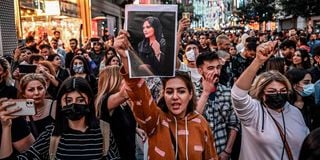The right to protest and its contours across the world

A protester holds a portrait of Mahsa Amini during a demonstration in support of Amini, a young Iranian woman who died after being arrested in Tehran by the Islamic Republic's morality police, on Istiklal avenue in Istanbul on September 20, 2022.
What you need to know:
- The freedom to protest peacefully is a human right in international law and requires authorities in all countries to facilitate assemblies by citizens to express displeasure at government action.
- The right to protest freely should be limited to public places or places that the public are entitled to access as of right.
- It held that the law was contrary to the right to protest, reasoning that substantive rights must supersede the procedure and not the converse.
This past week has been a busy one in most of the world. In the United Kingdom, there were anti-monarchy protests following the passing away of Queen Elizabeth II.
In Russia, there have been protests following a declaration by the president for a call-up of reserve soldiers for the war against Ukraine while Iran has been rocked by protests following the death of a woman who had died from beatings by the moral police supposedly because of having improperly worn the headscarf known as hijab.
In all these cases, though with different degrees of response, the authorities were accused of being too aggressive and out to suppress the rights of citizens to protest.
The freedom to protest peacefully is a human right in international law and requires authorities in all countries to facilitate assemblies by citizens to express displeasure at government action or policies in public places without unnecessary and disproportionate restrictions.
The right to protest freely should be limited to public places or places that the public are entitled to access as of right.
These could be public streets, parks and other public places that belong to the government.
Destruction of property
Simply put, a protest is an action or series of actions by either an individual or a number of persons in a public place to express feelings, often of disenchantment, about a public issue with either the intention that it be addressed or simply to bring it to public attention.
It is to be distinguished from a riot, which in law would be a situation where violence or destruction of property occurs or is intended to occur.
A riot would be illegal while a protest, irrespective of its rancour, would not be if no violence or harm to property or individual is intended.
In the United Kingdom, the right to protest is exercised and recognised as an amalgamation of the statutory rights to speech and the right to peaceful assembly.
Despite this, there is a long-standing common law offence of breach of peace by which protests may be curtailed.
Just this week, a man was arrested for shouting the words “Who elected him? – at King Charles III following his accession to the throne on the death of his mother, Queen Elizabeth II.
The man was to be charged with the offence of “behaviour likely to cause harassment, alarm or distress” under the Public Order Act of 1986.
Another woman found her right to protest under fire when she was arrested for “breach of the peace” for waving in public a placard with an obscene word and asking for the abolition of the monarchy in Britain.
There were protests that these offences were improper limitations of the right to protest under British law.
In the United States, the right to protest is protected by the First Amendment. It states that Congress shall pass no law which would abridge the right of speech, and of the people to peaceably assemble.
However, the courts have allowed some proportionate restrictions on this right such as the creation of buffer zones when protests are being held to ensure access to services for other persons.
Catch-all restrictions
The law, however, does not allow the use of catch-all restrictions against peaceful demonstrations especially if the only reasons are that the authorities are uncomfortable with the content of the protests.
A famous case in this regard was in 1963 when students who were protesting against segregation in South Carolina were arrested when they failed to heed a police order to disperse within 15 minutes.
The students were charged and convicted under a breach of the peace law. On appeal, the Supreme Court made it clear that the students’ action reflected an exercise of the right to protest and petition in the most pristine form.
Justice Potter Stewart added that there having been no threat of violence by the students, the state had acted unconstitutionally in passing a law that criminalised protest just because the views of the protesters may have been unpopular.
In a different case, the Supreme Court upheld a law that was used to arrest student protesters at a county jail who refused to vacate the driveway to the prison, thus blocking access to and from the prison.
A more recent case in the US involved President George W. Bush when Secret Service officers directed the police to move some protesters two blocks away from a restaurant where he was having his dinner while campaigning.
However, a group of demonstrators who were supporters of the president were not moved from where they were.
The result was that as the president was leaving the restaurant, he could only see his supporters but not those opposed to him.
The protesters went to court arguing that the Secret Service had acted not out of security concerns but simply to shield the president from their protest and had thereby abridged their freedom to protest.
The court reiterated that government officials may not exclude protesters in public places from expressing their protests solely because of fear, dislike or disagreement with the views of the protesters.
However, the court stated that it could not conclude that the actions of the Secret Service, in this case, were intended to insulate the president from hearing the protesters.
Component of democracy
The Supreme Court of India explained the right to protest as an important component of democracy.
It said that this right mandates the citizens to act as watchdogs by monitoring government actions to ensure social and legal justice.
It went further to state that democracy and dissent go hand in hand provided the protestors abjure violence.
In the year 2019, the court further affirmed the right against a law that was before parliament but held that the protesters could not occupy the public streets forever, especially where this affected commuters.
In another case, the Supreme Court, in response to a case where protesters were opposed to dams being built along the Narmada river, ordered that the building of the dam be stopped.
In the South African case of Mlungwana, a court held that the failure by protesters to give notice of an intended protest would not in itself justify sanctions of a criminal nature against the organisers and participants.
It held that the law was contrary to the right to protest, reasoning that substantive rights must supersede the procedure and not the converse.
But the South African case of Garvin would appear to have a chilling effect on the organisers of protests.
In it, a court upheld the constitutionality of the civil liability provisions of an Act which stated that organisers of gatherings would be liable for damages caused during protests and demonstrations if the protests turned violent.
Kenya’s law on the right to protest is hardly different from India and the United States.
The Constitution guarantees the right of assembly, demonstration, picketing and presentation of petitions to public authorities provided that this is done while unarmed and peaceably.
With regard to parliament, the constitution further gives a right to petition parliament to consider any matter within its legislative authority either for amendment, alteration or enactment of any law.
It does appear therefore that while the right to protest and demonstrate is universally acknowledged, its contours are fairly established and its core gives the citizens entitlement to speak truth to power without let or hindrance short of violence.
What may differ is how the authorities in different countries may respond to the persons seeking to exercise that bundle of rights.
Mr Owino is Head of Legal at Nation Media Group PLC. [email protected]





